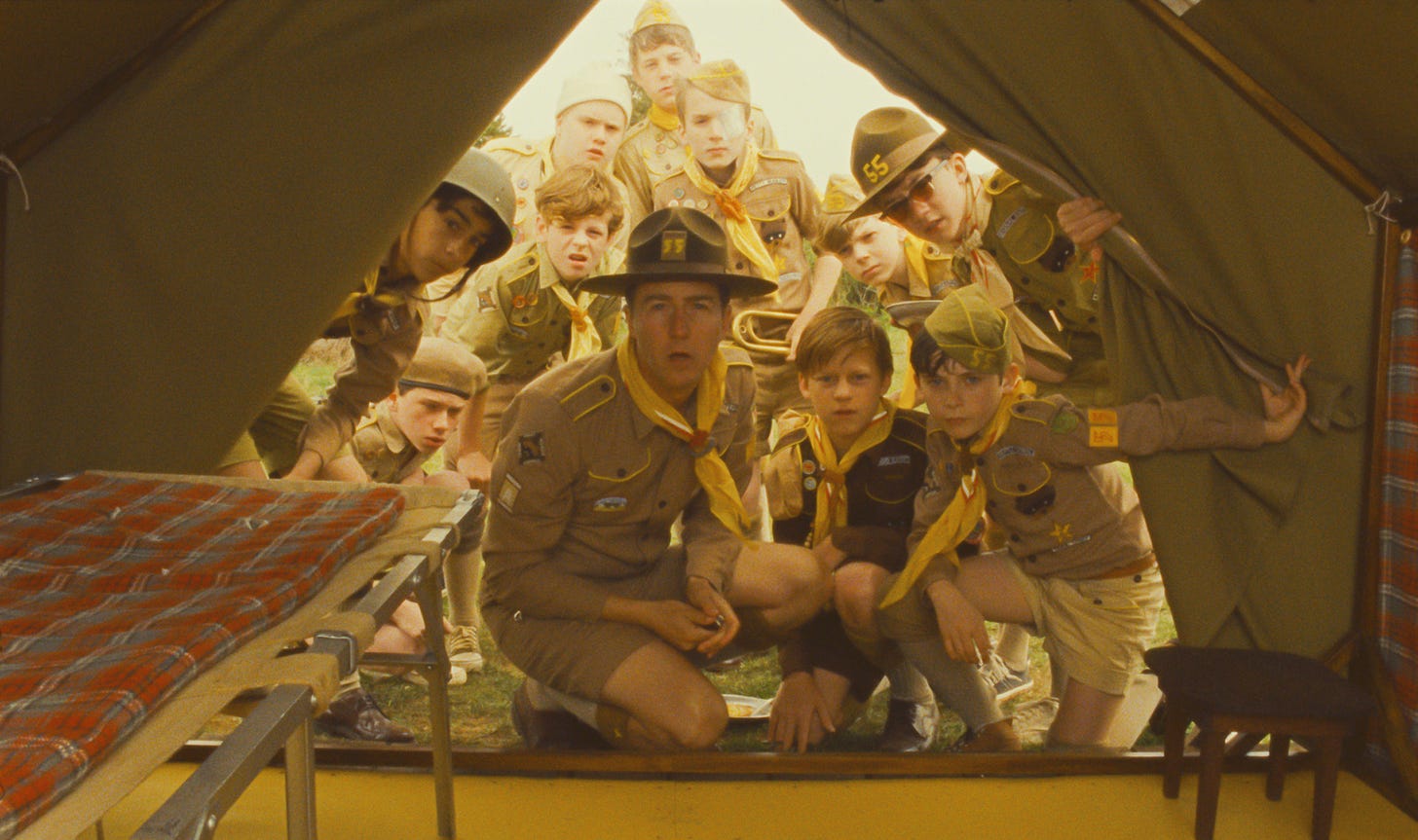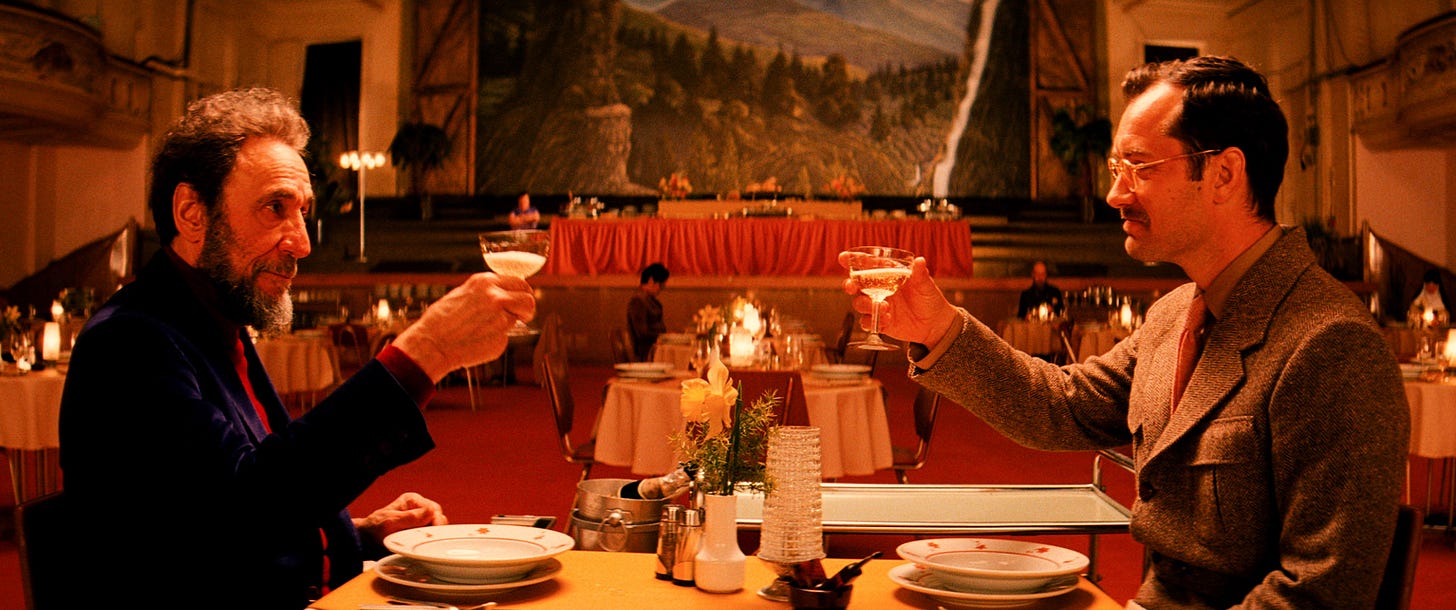The Sum Greatness of Wes Anderson's Twee Cinematic Parts
In a world of carefully-constructed artificiality, sincerity somehow prevails.
Looking back over my cinematic self-education, I am reminded that I’ve always been captivated by the films of Wes Anderson. “The Specter of Broken Fatherhood” was one of my favorite “anthology” pieces to write—for the record, I consider Moonrise Kingdom to be Wes’s final, hopeful answer to his decades-long grapplings with American’s paternal crisis—and I’m fascinated by the way his works build upon one another thematically, weaving clear strands of ideas through his entire whimsical filmography that tie them all into a strange yet coherent multi-film composition.
As someone who find the notion of “auteur theory” nearly always over-applied, I make a notable exception for Wes. His style is incredibly specific and baroquely-detailed, instantly recognizable in a way that most directors can only envy. Matt Zoller Seitz, author of the wonderful “The Wes Anderson Collection,” created a fantastic series of posts called “The Substance of Style,” and there’s something about that title that rings very true to me. His actors’ disconcertingly dead-pan performances; his legendary (and, frankly, absurd) symmetricity; the brightly-contrarian HSB pallet; those brilliant, pop-music-(under)scored slo-mo sequences (which remain one of the only stylistic uses of slow motion that I can stand); his other-worldly (literally) set-design—all add up to a style so overwhelmingly powerful and coherent and consistent that is becomes more than just a style.
It’s also weirdly passive-aggressive. It feels as though Anderson has taken every possible opportunity to come across as “realistic” or “relatable” or “authentic” and replaced it with the most emotionally-distancing artificiality he can muster. The rigid symmetry and strict stylistic rules he sets for himself seem like they would produce a controlled, predictable environment, but the opposite seems to be the case; they are so unrealistic that they quickly create an environment of thematic noise, near chaos for the viewer. “No,” he seems to be saying to his audience, “I’m not going to make this easy for you. This is uncomfortable and strange and distracting; that’s the point.”
All of which leads directly to why I’m so fascinated by his work. I can think of almost nothing which more perfectly captures the notion that “the sum is greater than its parts” than his films. I’m amazed by the fact that he can take so many unlikeable and unusual and unengaging elements and combine them into something far more sincere and authentic than any of those elements would suggest on their own.
In each of his live-action films, there is a moment where he steps from of the realm of the twee and the arch and the deliberately unreal into the realm of the moving, powerful, insightful, and real; a moment where his style becomes substance. What an astonishing and unusual ability—very nearly unique, in my cinematic experience.
In fact, the only analogy I can think of is a musical one. What Wes is doing is akin to that glorious moment when the towering theme of Purcell’s “Abdelazer” bursts forth from the cacophonous percussion of Britten’s “Young Person’s Guide to the Orchestra” and overwhelms us all with its power and its beauty. Perhaps that’s why Anderson ties that piece so closely to the story of Moonrise Kingdom. The way in which Britten’s musical chaos and Anderson’s familial chaos both resolve into order and peace is the perfect paring of two distinct (and distinctly memorable) works of art.
Here—with spoilers, so be warned—a list of a few of my favorite such moments:
Bottle Rocket: The look in Dignan’s eyes as he glances back over his shoulder at his friends in the film’s final frame, telling you that his joking nonchalance is all an act and he is desperately lonely and afraid.
Rushmore: The dance finale, wishing an astonishingly-kind farewell to a cast of characters that never quite seems to deserve that kindness.
The Royal Tenenbaums: Richie Tenebaum’s “Needles in the Hay” moment is one of the most quietly-horrifying things I’ve ever seen. Tipping slowly into the looming madness that everyone would have seen coming, if they could have bothered to look.
The Life Aquatic with Steve Zissou: Jaguar shark. Enough said.
The Darjeeling Limited: “I didn’t save mine.” The themes of dysfunctional fathers and the havoc they wreak on the lives of their children comes to a head in this film, and in this scene, in particular. I’m not convinced Peter and his brothers learn the lessons they should, but I think Anderson’s more interested in the reactions of his audience than those of his protagonists, at that moment.
Moonrise Kingdom: The nighttime conversation between Mr. and Mrs. Bishop where they realize that they, as parents, will never be “enough” for their children is both sorrowful and reassuring. Their choice during the film’s tempestuous denouement is the definitive response to Anderson’s long-gestating questions on fatherhood.
The Grand Budapest Hotel: “No, the hotel I keep for Agatha.” My favorite moment from any of Anderson’s films, the revelation that the loud and melodramatic relationship between Gustave H. and Zero was never the one at the heart of the film is just perfect.
The French Dispatch: Roebuck Wright’s realization that loneliness and beauty often go hand-in-hand (for him, at least). Interestingly, this film is also the first time that I felt as though Anderson’s style did not move into substance. In Dispatch, the final episodic, unfocused sum is most definitely not greater than its parts.








